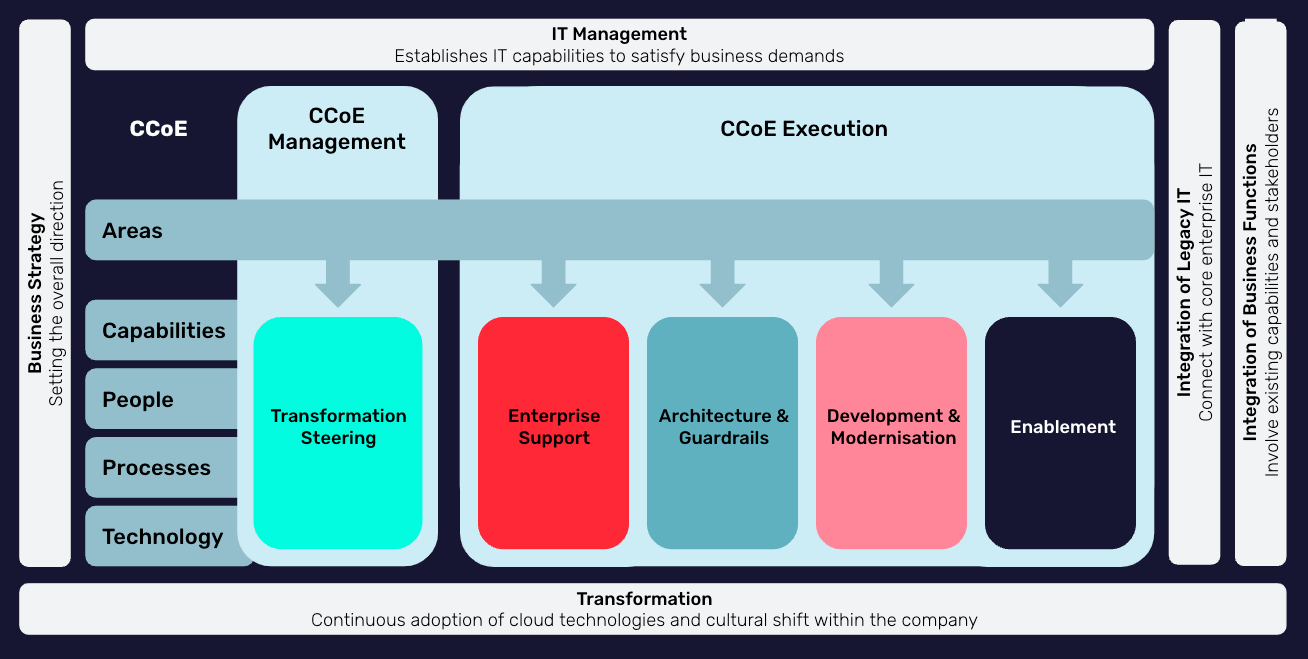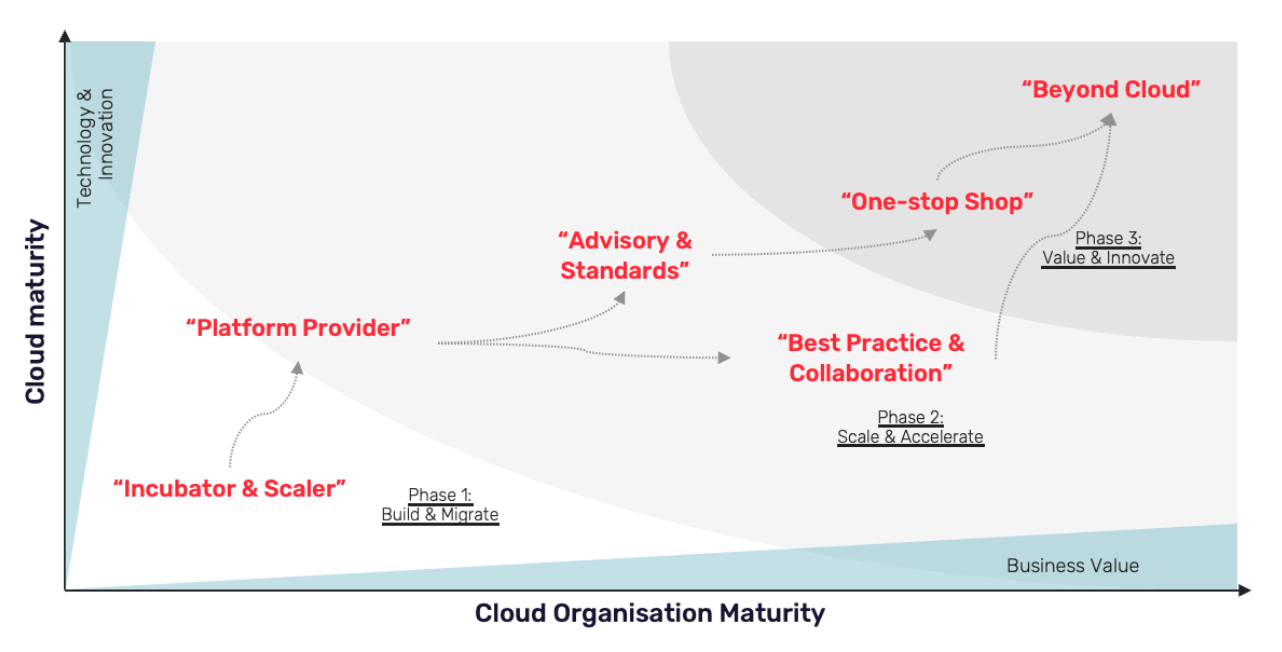
Building a CCoE in 2024: What You Should Do Differently
Why does cloud adoption often stall?
In lots of companies right now, IT departments are facing shared challenges because of the way they initially approached their cloud journeys.
Starting with a purely technology-driven transformation, often advised and directed by hyperscalers, has led to subpar conditions for their cloud environments. Basically, it meant creating modern technology infrastructure without:
- Defined use cases
- A proper way to govern
- Plans for efficient operations
The lack of strategic elements and proper ways to enable the whole organisation (not just IT) on cloud led to stalled enterprise cloud adoption and untapped cloud potential.
Enter CCoEs…
CCoEs: The early days
In response to this stalling in cloud adoption, these companies set-up their own Cloud Centre of Excellence. These were built on traditional cloud governance structures, with the aim of accelerating adoption and overcoming technical challenges and ensuring the kind of ‘excellence’ that leads to high-performing cloud operations.
However, CCoE’s have not kept pace with the various stages of enterprise cloud journeys, as the initial design doesn’t change with evolving needs of the client and cloud programmes. They were designed focusing mainly on governance, built with mainly Architects and resulted to be the same old ivory towers that enterprise architecture has traditionally been. They lacked engineering execution power and therefore resulted in blueprints, guidelines and restrictions only.
Second wave CCoEs tried to centralise everything including all development on the cloud into one organisational unit, which in return made them bloated and complex.
In essence, CCoEs became classic IT departments based on old structures and hierarchies. The real company wide cloud adoption was still missing.
Second wave CCoEs tried to centralise everything including all development on the cloud into one organisational unit, which in return made them bloated and complex.
What the third wave of CCoEs should do differently
Modern CCoEs (the third wave) should implement best practices learned via the first few iterations.
This includes setting governance and best practices, and enabling standardisation. But it also means offering core cloud services (e.g. platform services) in an easy-to-consume way.
A CCOE should act as an overall service broker for the enterprise. Let’s consider the 6 objectives of a CCoE and the areas of expertise needed to achieve this.
The 6 objectives of a CCoE
The 6 primary objectives of a CCoE are to:
1. Provide access to stable cloud platform and respective services, based on which business unit can develop and create new applications (this is the service broker function)
2. Lead the modernisation of legacy applications by providing consultancy to business units
3. Enable the whole organisation in cloud technology by providing training, guidance and advice
4. Define best practices, guidelines and blueprints that are tailored to the company’s cloud use-cases
5. Govern cloud platforms to ensure efficient infrastructure usage and cost efficiency
6. Accelerate agile working practices for adoption amongst the enterprise
The setup of such a CCoE should be an iterative endeavour, otherwise it will overburden the organisation and result in subpar results. Nordcloud has broken down the tasks into different focus areas aligned to current cloud goals of our customers.

Scaling Cloud Success
See how we helped NHS England’s CCoE scale cloud across the National Health Service.
The expertise you need for a CCoE
A CCoE has to be deeply connected with the rest of the company and must incorporate different areas of expertise. These are:
1. CCoE management
As an organisation, the CCoE is managed by a CCoE manager (typically CIO -1) and supported by a chief architect. They steer the cloud transformation according to the cloud strategy, measure and report the benefits and meet the CCoE’s objectives.
The CCoE manager is the custodian of cloud standards and relevant expertise.
2. CCoE execution
This represents the activities that are part of meeting CCoE responsibilities and satisfying CCoE objectives.
Execution activities are performed by CCoE roles working closely with business and technical teams, and should empower them to perform to the highest standards. Activities are provided in governance, service brokering and community-building modes.
And there are 4 key drivers of excellence in CCoE execution. These are:
1. Enterprise Support
- Shaping industry cloud demand
- Developing relationships with customer business units and technical teams
- Analysing cloud vendor market solutions to advise teams on procurement choices
- Performing management of cloud usage and spend
2. Architecture and Guardrails:
- Governing the use of cloud technology by proposing best practices and determining policies for business, information, technology and security architectures in multi-cloud environments
- Resolving complexity and accelerating cloud service adoption
- Setting guidelines and guardrails to constraint operations and manage risks
3. Development and Modernisation:
- Providing access to the basic cloud services like scalable platforms, CI/CD pipelines and public cloud platforms
- Helping technical teams engineer on cloud-based platforms for developing and deploying of cloud-native applications and services which are secure- and compliant-by-design
- Supporting the migration of workloads to multi-cloud environments
4. Enablement:
- Engaging with organisation through community-building, enhancing learning and knowledge-sharing across organisation
- Upskilling people in cloud
- Developing a culture around cloud transformation
Our CCoE One View reference model
Nordcloud provides in-depth guidance on how to set-up those areas with regards to capabilities, people, process and technology as outlined in our CCoE One View reference model:

Nordcloud CCoE One View reference model
The setup of such a CCoE should be an iterative endeavour, otherwise it will overburden the organisation and result in subpar results. Nordcloud has broken down the tasks into different focus areas aligned to current cloud goals of our customers.
This approach to a CCoE allows a company to focus on exactly the right capabilities at the right time, all in alignment to the overall customer Business/IT/Cloud strategy.
With this approach, customers can keep their CCoE up to date depending on their current technology (cloud) and organisation maturity as shown here:

Nordcloud PoV on CCoE evolvement based on cloud and organisation maturity
Need help with your CCoE?
Nordcloud Advisors can design your cloud organisation, embedding best practice and driving sustainable cloud adoption. We also empower your teams, nurturing them as we navigate the implementation journey. That way, your champions are engaged in and driving the change. After all, cloud is more than just new technology, it’s a culture change, encompassing new operating models and governance, too.
So, if you're currently struggling with the setup of a CCoE or feel like your CCoE is not performing up to its potential, see how we can help and get in touch here.

Let's Talk About CCoE
Connect with our CCoE experts to discuss how we can help with your cloud journey – migration, modernisation, development and upskilling.
Get in Touch.
Let’s discuss how we can help with your cloud journey. Our experts are standing by to talk about your migration, modernisation, development and skills challenges.



